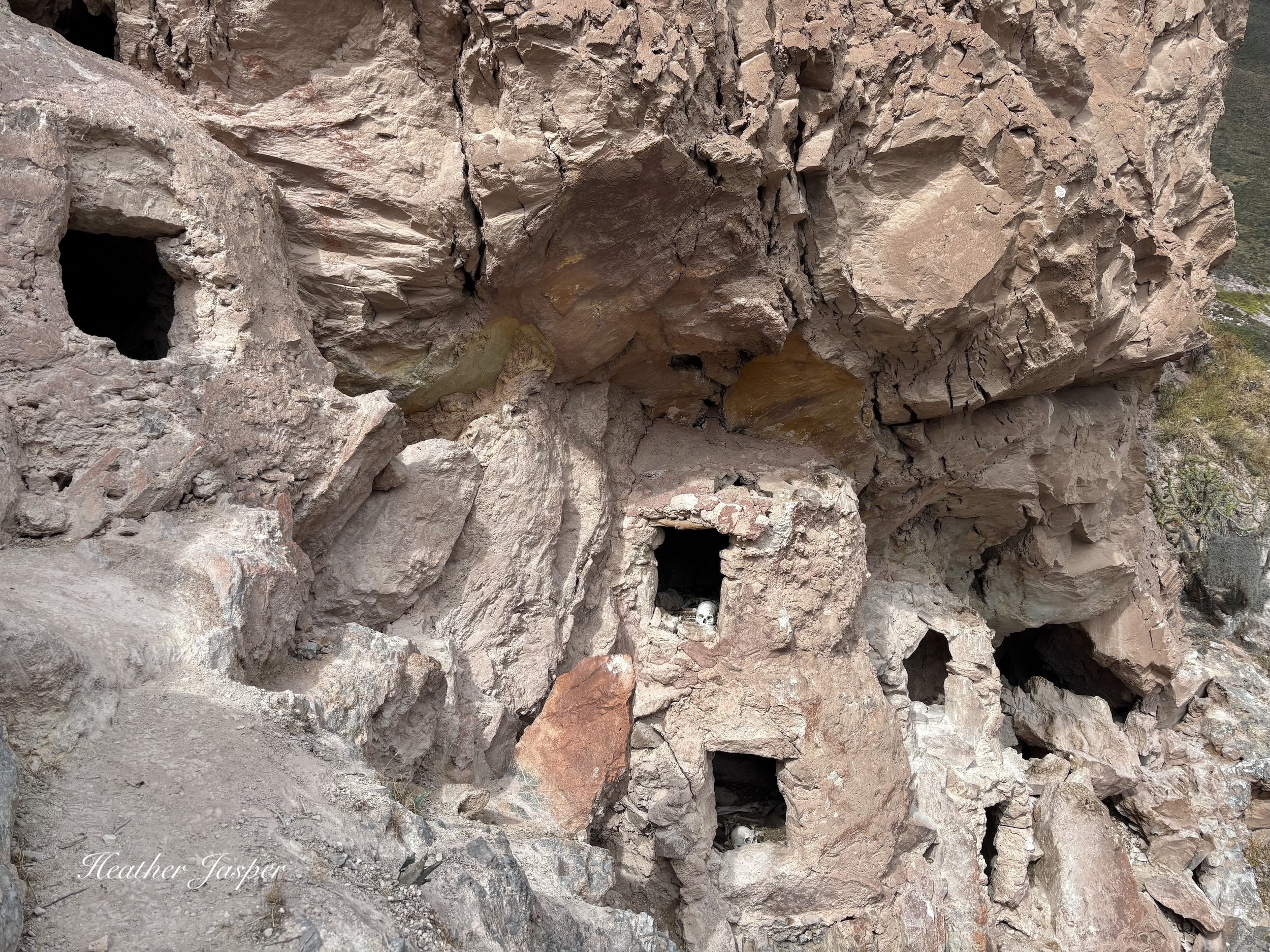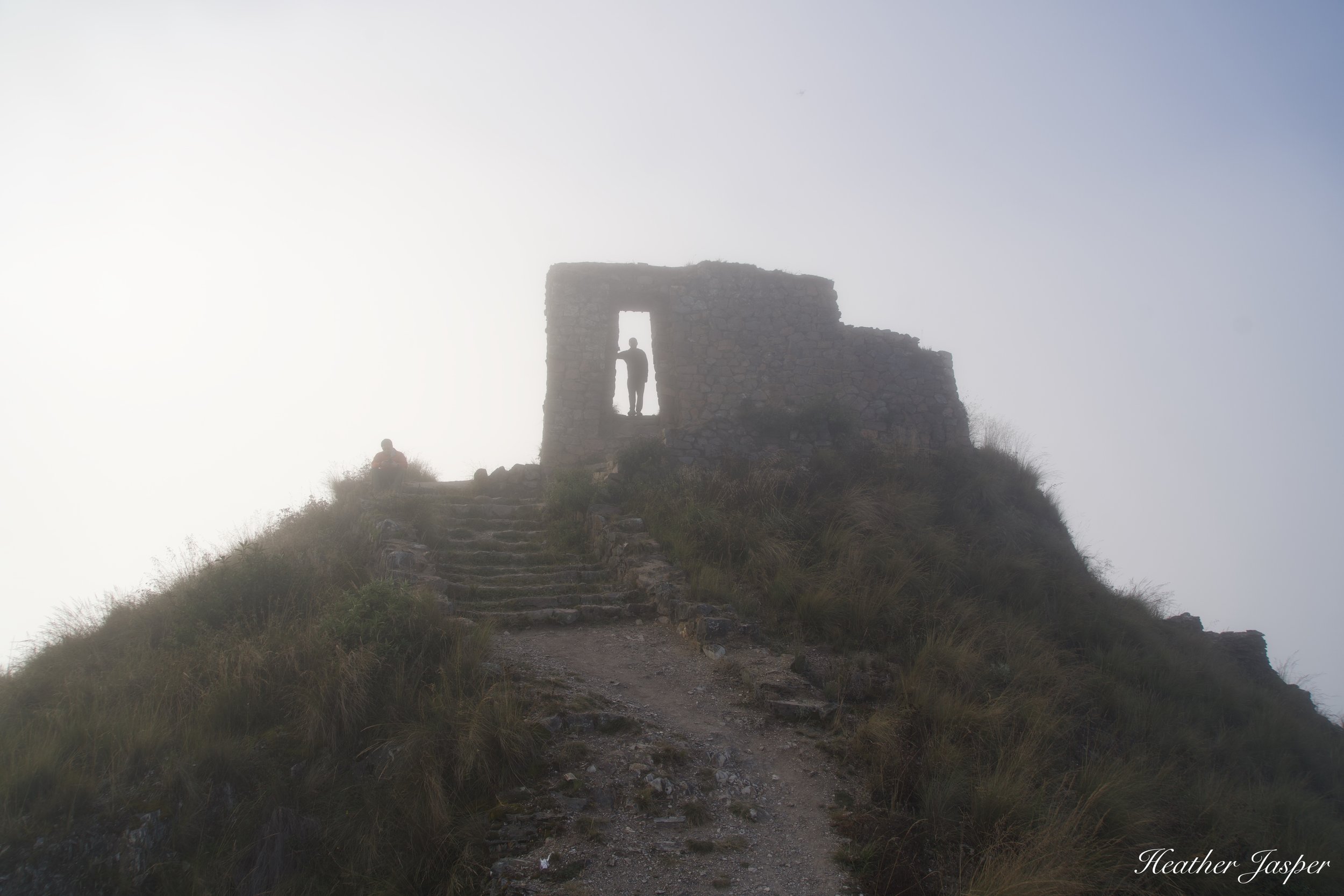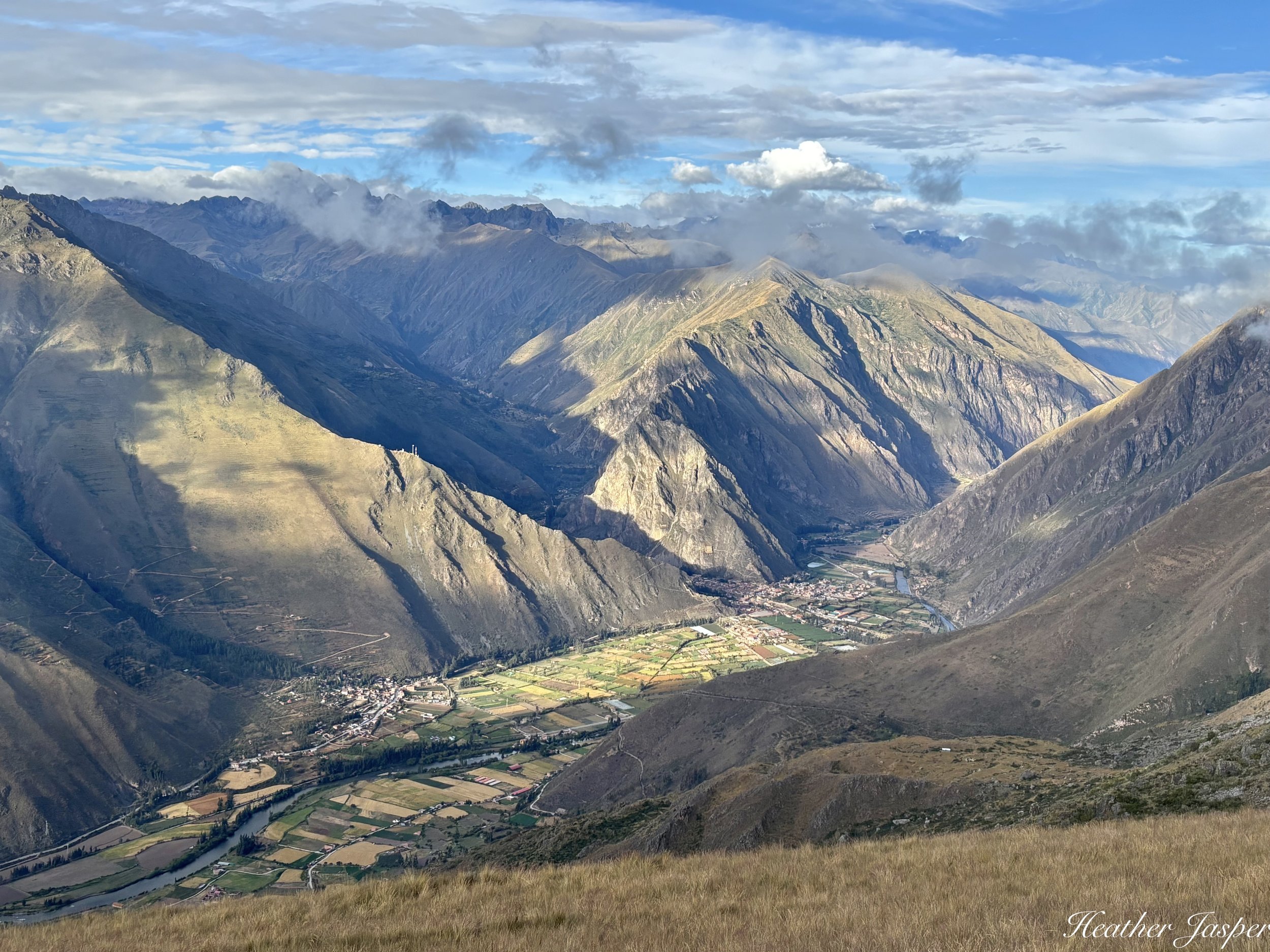Quarry Trek
I loved this trail and recommend it to anyone who wants a trek near Machu Picchu without the crowds!
The Quarry Trek has exactly what I look for: beautiful landscapes, waterfalls, rural communities, birdwatching and no crowds.
I did this trek May 20-22 with Intrepid on an unusually cloudy week, after the rainy season ended. The first day we hiked about 5 miles, the second day was about 8 miles and the third day was another 5 miles. The highest elevation is 14,600 feet above sea level on the second day.
Day 1: Cusco to Socma
I was picked up at 4:45am in Cusco so I could meet the group in Ollantaytambo at 7am. I highly recommend spending the night in Ollantaytambo so you can sleep another hour or two. From Ollantaytambo we drove to the village of Socma to visit an ancient Inca cemetery and hike up to the Perolniyoc waterfall and the Inca ruins of Raqaypata.
Inca cemetery
All the tombs have been looted, but many still have the bones of the people buried there.
The cemetery is built into the cliffs of a promontory high above the canyon. Some of the skulls show signs of trepanation and a few were elongated, an ancient tradition practiced by some Andean cultures. For centuries it was common for people to keep the skulls of their beloved ancestors, especially parents, in the home. Every morning, they put fresh food and drinks in front of the skulls and treat them as current members of the family, but the practice has almost disappeared. I only know a couple families who still do this.
Next, we walked to the Perolniyoc waterfall, which I had visited before as a morning trip from Ollantaytambo. This time there was a lot more water and when we hiked up to the opposite side of the canyon, we could see the two drops that are partly hidden inside the cliff.
Raqaypata
Some buildings look residential, but most are clearly ceremonial, and this one has windows that can be used to track the equinox and solstice.
Up above the canyon, we made it to the Raqaypata Inca ruins. The true purpose of the buildings was lost during colonization but about ten years ago the area was carefully restored and it’s a beautiful place to visit.
Another half hour up past Raqaypata we came to our first campsite, above the community of Socma. Camp was set up, hot drinks ready and basins of hot water to wash with. I washed the dust off my face and neck, then poured the water over my feet, which felt amazing. The hot drinks and water are standard on guided treks in Peru, which are luxurious compared to camping trips in every other country I’ve visited.
For this 3-day, 2-night trek my guide was Hebert Peralta (contact Hebert on IG), the cook was Valentino, the muleteer was Eusebio and his assistant was Melquiades. They already had the tents set up: four tents for us to sleep in, the dining tent, the cook tent and another tent for Eusebio and Melquiades. Valentino slept in the cook tent.
Hiking by villages
I liked seeing how people still farm the terraces made by Inca and pre-Inca cultures centuries ago.
Compared to the other treks I’ve been on in Peru, this team had the best sleeping arrangements. The worst I’ve ever seen is on the Inca Trail, where most companies make porters and cooks sleep in the dining tent, which doesn’t have a floor. The porters wait until the clients are done with dinner, then they break down the tables and move out the chairs so they can all sleep on the muddy ground. They get up early to set up the tables again so the clients can have breakfast.
This is one of the many reasons that I prefer treks like Lares, Choquequirao and Salkantay over the Inca Trail.
Lunch appetizer
Valentino made fantastic meals every day and impressed us with edible flowers and creative touches.
On this trek, we had five horses but only three were loaded with the camping equipment at a time. Eusebio, who owned the horses, switched which ones were carrying gear at lunch, so two of them always had only a saddle. The rotation gave them a break and meant that two were always available if somebody was too tired to hike. Nobody needed to ride on this trip, but it’s always nice to have the option.
This wasn’t my first time here. In 2021 I hiked up to the Perolniyoc waterfall with some friends and in 2020 I took emergency supplies to the village. Villages like Socma were isolated during the pandemic and most people lost their jobs. I worked with a couple friends to take food and other emergency supplies to sixteen villages in 2020.
The second morning started out with cloud cover, which was very helpful because it was a long uphill climb.
Day 2: Socma to Cachiccata
The second day is when we get to see the quarries where the Inca’s engineers got the pink granite they used to make most of the temples in Ollantaytambo. The pink granite used in buildings in Cusco was also brought from these quarries.
This was the longest day and over half of it was at over 14,000 feet above sea level (more than 4,000m). We started early with a 5am wake up and coffee in our tents before breakfast at 5:30. Like the hot water for washing, coffee in your tent a half hour before breakfast is standard on guided treks in Peru. They always offer coca leaf tea, coffee or just hot water. It’s easy to get spoiled here.
Guided treks in Peru are full service
We packed up our gear before breakfast and while we ate Melquiades broke down the tents for us.
The hike started out in a valley that people still live in, with ancient terraces they still farm. We walked past fields of wheat, barley, oats, potatoes and fava beans. We saw cows, pigs, horses and lots of sheep. Around 6am we saw kids walking downhill, heading to the elementary school in Socma. For high school kids have to move to Ollantaytambo or even go all the way to Cusco.
It’s easy to romanticize living in rural Peru, but it’s a hard life with little access to education and healthcare. Most people who leave to go to high school stay in cities or larger towns to find work and rarely come back to the villages.
Cultivating water
Inca & pre-Inca cultures carefully controlled the water supply. The lines on this hillside lead runoff to the stream in the middle of the valley to increase the water available for terraced farming far below.
Alone in the mountains
After we left the homes around Socma, the only person we saw all day was this woman leading two lambs.
Inti Punku in a cloud
It was foggy when we finally got to Inti Punku. Read my blog about my first time at Inti Punku here.
The hike across the top of the mountains took us through a dry grassy area called puna in Quechua. From above, we could see Inti Punku’s ancient stone doorway but once we got down there it was completely socked in with fog. Inti Punku means “sun gate” in Quechua, and it’s a modern name for an ancient place that was clearly used for astronomy and probably also to show respect for the surrounding sacred peaks, called apu in Quechua.
We waited until the clouds parted a bit and we got a view of Wakaywillka right in front of us. The peak is called Veronica in Spanish, but the Quechua name means “sacred tears” in reference to the mineral-laden water that comes from the mountain’s glaciers to fertilize the crops in the Sacred Valley.
Leaving Inti Punku the clouds parted enough to see it with the peak of Wakaywillka behind. The sign says: If you want the rainbow you have to face the rain.
Day 3: Cachiccata to Ollantaytambo
Our last breakfast with Valentino, Eusebio and Melquiades was pancakes with strawberries and kiwi. Hebert brought three envelopes, each with one of the guy’s name on it, for any tips that we wanted to give them for their hard work. We each put in s/120 soles, with Valentino getting a bit more to show our appreciation for the excellent food and the years he surely spent learning to cook such extravagant meals on a camp stove.
We woke up in the same fog that covered Inti Punku the night before but as soon as we started hiking we were below it. Ollantaytambo, far below, was sunny. The walk is all downhill and goes through several areas of the quarry with partially carved stones.
The main archeological site in Ollantaytambo was still under construction when the Spanish invaded. It was never finished because the effort to fight the Spanish ended the construction and killed off the engineers and expert stone masons.
The trail ends at a bridge across the Urubamba river, where we crossed over to the town of Ollantaytambo.
How does the Quarry Trek compare with other treks near Machu Picchu?
Compared to every other trek I’ve done, the quarry trail had far less people. There were no other groups at the campgrounds where we stayed and on the trail we only saw a few other people who live up there but no other international travelers. There were a few tourists at the Raqaypata Inca ruins and the Perolniyoc waterfall, but as soon as we hiked above Raqaypata we didn’t see any other tourists until we got to Ollantaytambo. At Inti Punku we saw one young woman from Cusco and her mother, but nobody else.
Like every trek except the Inca Trail, we had horses to carry the camping equipment, including our sleeping bags and another 3kg of personal gear like our extra clothes and warm jacket for cold nights. (Only the Inca Trail has human porters). Eusebio owned the five horses we had with us, and he said that depending on the horse and the number of treks who want to hire them, each animal rests 2 to 4 weeks between treks. Only three horses were carrying gear at a time to let two rest, and he switched which ones were carrying the heaviest loads at lunch to let them rest in the afternoon. The two extra horses were available for us to ride if we got too tired to hike or if somebody got injured.
The Lares trek goes through more villages, so if you want to interact more with local people, that would be a better trek. Lares also has hot springs, which Quarry does not.
This is the only trek near Cusco where you can see ancient tombs that still have the skulls of the people buried there. It is also the only trek that shows you where the Inca’s engineers got the pink granite they used for their finest architecture.
The only Inca ruins on the Quarry trek are Raqaypata, so if you’re most interested in Inca architecture you should consider Choquequirao. However, if you combine Quarry with the 1-day Inca trail from km104 you get the best of both worlds.
I highly recommend combining the Quarry trek with the km104 day hike! With this combination, you would spend the night after the Quarry trek in Ollantaytambo at a hotel, then early the next morning take the train to km104. You hike the last day of the Inca Trail, arriving at Machu Picchu in the afternoon, usually about the time it closes, then spend the night in Aguas Calientes, getting a full tour of Machu Picchu the next day.
Hebert Peralta
Hebert is an excellent guide who also works freelance for hiking, mountaineering and rock climbing around Cusco & Huaraz. Contact him on IG or WhatsApp +51 931 723 514.









































